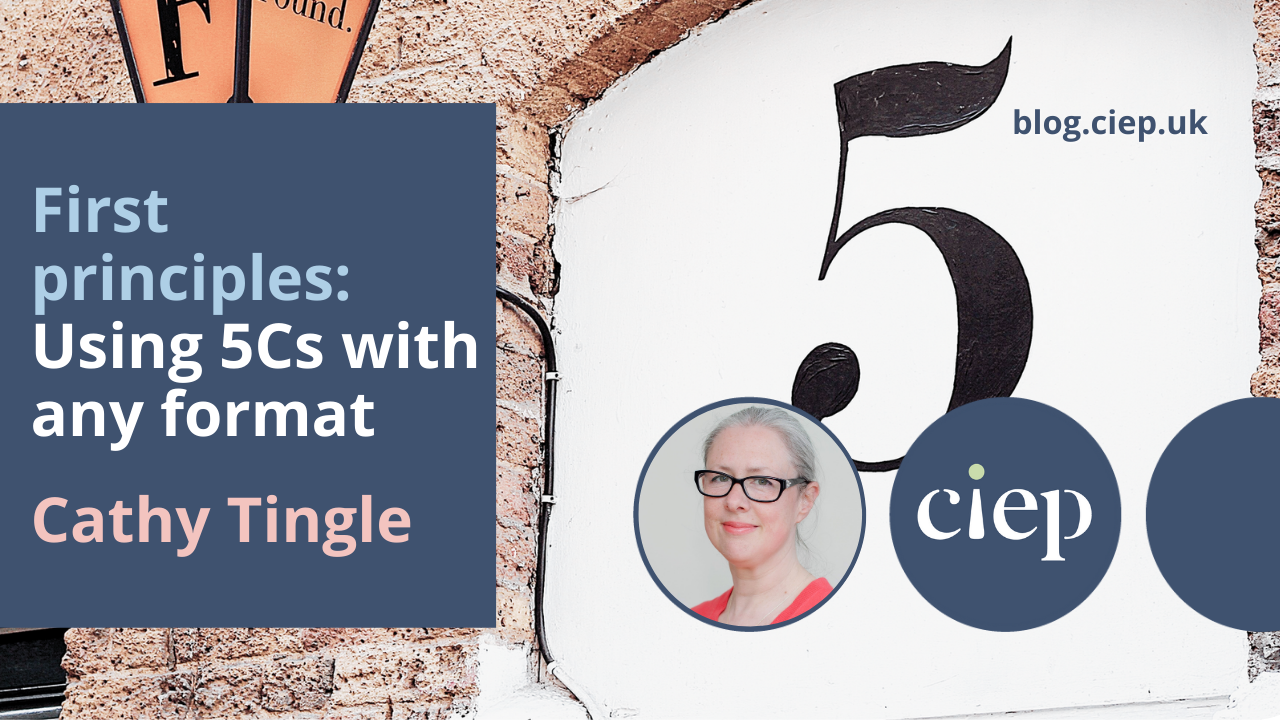Whether you’re a professional copyeditor or have been asked to check text as part of your wider job, the focus is always on communication. As Cathy Tingle, author of the new CIEP guide Editing for Communications Professionals, explains, there are other Cs that can provide a framework for making sure that text communicates the right message.
Many copyeditors work with books, or book-like formats such as journal articles or reports. But what if you’re asked to work on something with quite another shape entirely, like a board game or a set of exhibition labels?
If you’re facing a situation like this, it’s a good idea to go back to basics. Copyeditors have been given a ready-made set of principles with which to tackle any job. The principles are brilliant in their versatility. They’re also brilliant because, like ‘copyediting’, they all begin with a C, so they’re easy to remember, even when you’re in a flat panic about where to start.
And they all sit under one overarching C. Amy Einsohn and Marilyn Schwartz in The Copyeditor’s Handbook call this the ‘cardinal C’: communication.
Which Cs?
Different copyeditors apply slightly different C-based principles to their work, as demonstrated in a January 2022 Twitter chat instigated by editor Jonathon Owen. Some cite three Cs, some four, some seven. The two that are usually included are clarity and consistency. Einsohn and Schwartz add coherency and correctness; others cite concision and comprehensiveness. Some copyeditors don’t use the Cs at all. In Owen’s thread, Random House copy chief Benjamin Dreyer comments, ‘Wait, is this really a thing?’
I’ve found a certain set of Cs useful. I learned them when training, and editing experience has only increased my enthusiasm for them. They are a basic four:
- Clarity
- Consistency
- Correctness
- Completeness
Plus one, which I’ve added after working with different formats. The five together have enabled me to get my bearings on practically any job:
- Convention
For the rest of this article, we’ll look at these 5Cs. For each I’ll suggest two questions you might ask of the text that’s in front of you, even if it’s in a format you haven’t tackled before.
Clarity
When you check the text with clarity in mind, you consider whether the audience will receive the writer’s intended message loud and clear without confusion – or what communications professionals call ‘noise’. Clarity covers the sense of the text, but it can also apply to structure – making sure the reader has an easy time of navigating the points the writer is trying to make.
Here are two questions you could ask to improve clarity:
Does the reader have a clear path through the text?
If not, consider measures like adding subheads, breaking up long paragraphs, putting explanatory information into features like boxes or side bars, ordering and pulling out important points, perhaps with lists and displayed text, and including clear introductory text and a call to action.
Is the language as plain as it can be?
If not, look at how you can break up longer sentences into shorter ones, swap language that has a Latin or Greek origin (like ‘consume’) for more Anglo-Saxon words (like ‘eat’) and generally try to reduce syllable count. Use punctuation correctly to maximise clarity without adding words.
Consistency
Editors look to style and other regular features within the text when they consider consistency. For people working in communications, consistency includes brand consistency, which will affect areas like tone of voice and making sure an organisation’s brand values are reflected in all content.
Here are two questions you could ask to improve consistency:
Is there a house style to follow?
You should have the basics of a house style, even if it’s a reference to an external style guide. If you have to start from scratch in building a house style (and you won’t be the first), it’s important to base it on the overarching principles of what you already do, pairing it with an external style guide, particularly at first, to make any new style decisions.
How does this work with the rest of the suite?
Look at the whole picture when you’re applying the principle of consistency. A piece of text is rarely a one-off. It usually comes from an author who has published other content, or is produced by an organisation that has its own branding, website and social media presence. It’s good practice, and inspires trust in your audience, if you get all the content from one stable as integrated and coherent as possible.
Correctness
When working with book formats, correctness covers checking the sort of details that can reasonably be verified. This helps the reader maintain their trust in the author or publisher. With business content, or marketing content, this trust extends to the organisation and the brand.
Here are two questions you could ask to improve correctness:
Are the facts right?
For an organisation this might extend to checking with colleagues whether claims for a product, service or idea will be delivered as stated. But a good place to start in answering this question is always with the proper nouns in the text – that names, places and events are spelled, hyphenated and capitalised correctly.
Are there any legal or inclusivity issues?
You might have to go to more knowledgeable colleagues for this. At the least, consult outside sources that give the latest information on conscious language or copyright issues. Make yourself as alert as you can to anything in the text that might be a legal issue, including libel, slander and copyright. Then apply the same level of attention to whether the text is inclusive. Is everyone being referred to with dignity and respect? Is there a representative range of voices? Is the text reflecting up-to-date best practice in this area? Familiarising yourself with conscious-language resources like the Diversity Style Guide will help develop your awareness.
Completeness
In book formats, completeness often means the author’s promises are fulfilled – that cross-references work, that the information promised, perhaps in an introduction, is supplied for the expectant reader. In business text, ensuring completeness helps keep the brand promise – the experience the audience expects every time it’s in contact with the brand.
Here are two questions you could ask to improve completeness:
Has all the directly promised information been supplied?
This might range from including clear guidance on payment options in a brochure entitled ‘Your guidance on payment options’ to web links that work. Whenever the author mentions a number of points they will make, check all those points are present.
Has all the indirectly promised information been supplied?
Also think about what the reader might expect, even if you haven’t directly promised it: captions for pictures, a contact email in case of questions. Beta readers can help to find these sorts of gaps.
Convention
There are conventions in every field. A press release will be formatted and worded differently from an entry in a dictionary. An exhibition label in a gallery will need to present information in a format that’s agreed across the sector. Even websites have conventions.
Here are two questions you could ask to make sure you comply with convention:
Am I familiar with the conventions in my field?
Your conventions will act as the boundaries you work within, so make sure you’re clear on what can be done in areas like structure, wording and cross-referencing. Keep guidelines close and refer to them often.
Who’s my audience?
Your audience are likely to pay little regard to whether you’re conforming to convention, but they will know if something’s familiar, consistent and makes sense to them. So far so good. But convention in certain fields can sometimes be expressed as specialist language and jargon. If this is unavoidable, make sure you include a form of explanation – boxes, glossaries, illustrations. Always remember to cater for your least specialist reader.
Ask your own questions
The magic of the 5Cs is that each C means something slightly different, depending on factors such as format, audience, sector, brand and brief. Start a project by considering these 5Cs, and asking your own questions within them. It will help you familiarise yourself with exactly what you have to do, and make sure your audience gets the message they’re supposed to receive. When that happens, you’ll have achieved what we’re all aiming for – the cardinal C of communication.
Resources
Crystal, D. 2020. Imagine an editor. CIEP focus paper. ciep.uk/resources/factsheets/#IAE
Cutts, M. 2020. Oxford Guide to Plain English. 5th edition. Oxford University Press.
The Diversity Style Guide. diversitystyleguide.com
Einsohn, A., and Schwartz, M. 2019. The Copyeditor’s Handbook. 4th edition. University of California Press.
Smart, P. 2022. Copyright. CIEP fact sheet. ciep.uk/resources/factsheets/#COP
Thomas, C., with Saffrey, A. 2020. Your House Style: Styling your words for maximum impact. 3rd edition. CIEP guide. ciep.uk/resources/guides/#YHS
About Cathy Tingle
Cathy Tingle, an Advanced Professional Member of the CIEP, is a copyeditor, proofreader, tutor and CIEP information team member.
 About the CIEP
About the CIEP
The Chartered Institute of Editing and Proofreading (CIEP) is a non-profit body promoting excellence in English language editing. We set and demonstrate editorial standards, and we are a community, training hub and support network for editorial professionals – the people who work to make text accurate, clear and fit for purpose.
Find out more about:
Photo credits: header image by Toa Heftiba, question marks by Leeloo Thefirst, documents by Tiger Lily, all on Pexels.
Posted by Belinda Hodder, blog assistant.
The views expressed here do not necessarily reflect those of the CIEP.



